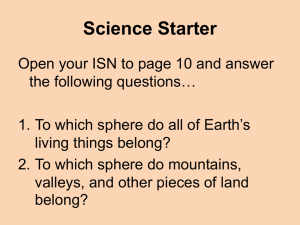Lesson Plans - Warren County Schools
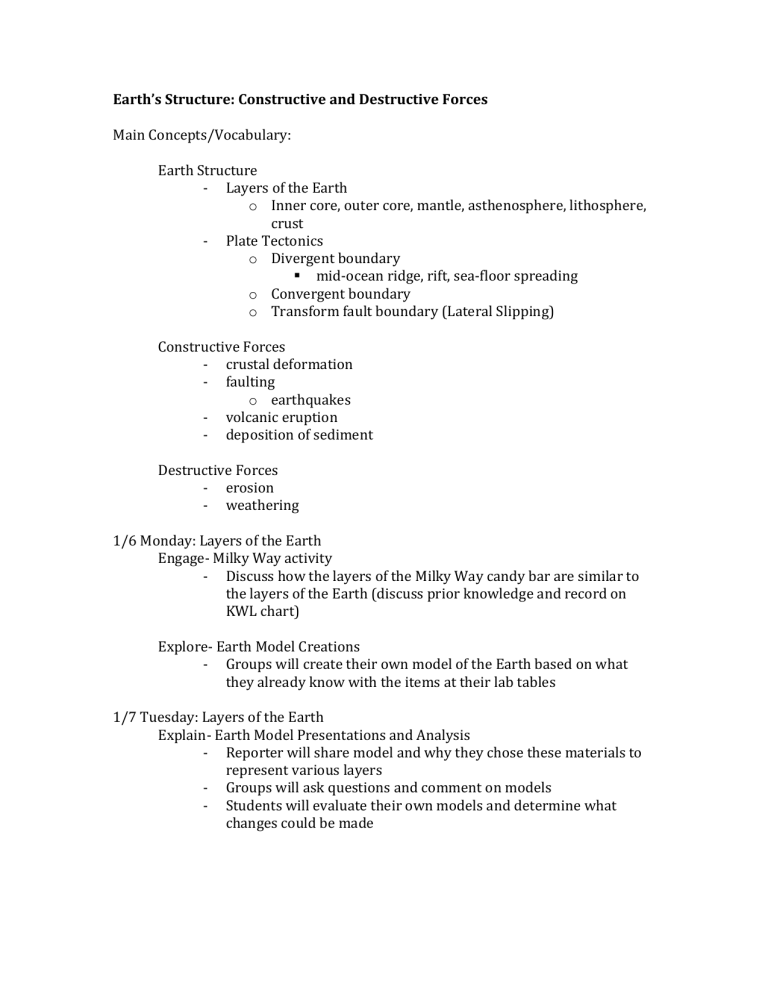
Earth’s Structure: Constructive and Destructive Forces
Main Concepts/Vocabulary:
Earth Structure
Layers of the Earth o Inner core, outer core, mantle, asthenosphere, lithosphere, crust
Plate Tectonics o Divergent boundary
mid-ocean ridge, rift, sea-floor spreading o Convergent boundary o Transform fault boundary (Lateral Slipping)
Constructive Forces
crustal deformation
faulting o earthquakes
volcanic eruption
deposition of sediment
Destructive Forces
erosion
weathering
1/6 Monday: Layers of the Earth
Engage- Milky Way activity
Discuss how the layers of the Milky Way candy bar are similar to the layers of the Earth (discuss prior knowledge and record on
KWL chart)
Explore- Earth Model Creations
Groups will create their own model of the Earth based on what they already know with the items at their lab tables
1/7 Tuesday: Layers of the Earth
Explain- Earth Model Presentations and Analysis
Reporter will share model and why they chose these materials to represent various layers
Groups will ask questions and comment on models
Students will evaluate their own models and determine what changes could be made
1/8 Wednesday: Layers of the Earth
Elaborate- Earth Model Redesign
Groups will explore the asthenosphere and the lithosphere via the
MIT K-12 video and answer critical thinking questions about this new knowledge of earth layers (FA)
“How could you redesign your model to include these two new layers?” (FA, Evaluation)
Add information to KWL chart about layers of the earth
Evaluation- Formative assessments have occurred throughout this lesson, but students will be summatively assessed at the end of the unit
1/9 Thursday: Plate Tectonics
Engage- Layers Model
Share asthenosphere and lithosphere example (Oobleck and cardboard) to show how plates in the lithosphere move and collide
Explore- Open-ended question (Partner Activity)
“What happens when these plates collide?”
“Do you think the Earth’s surface has always looked the way it does today? How do you know?” (FA)
Explain: Open-ended question (Partner Activity
Partners will split and find a new partner to share their answer with and discuss ideas
Students will defend their reasoning and evaluate another student’s response
1/10 Friday: Plate Tectonics
Elaborate- Continental Drift Reading
Partners will read about continental drift and how plate tectonics have changed the location of the continents over the past 250 million years
Students will use this information to refine their previous answers
Evaluation- Formative assessments have occurred throughout this lesson, but students will be summatively assessed at the end of the unit
1/13 Monday: How Earth’s Plates Move
Engage- Shoe box plate demonstration
Using a shoe box, the teacher will demonstrate how plates can move in various ways
“What happens to the crust of the earth when these plates move?”
Explore- Shoe box plate activity
Lab groups will experiment with their plates to determine all the possibilities of how plates can move and what impact that may have on the earth’s surface
Explain- Shoe box plate activity
Reporters will share their movements and hypotheses about how this may impact the surface of our earth
1/14 Tuesday: How Earth’s Plates Move
Elaborate- Shoe box plate activity
Students will read about the three kinds of plate boundaries
They will use this information to reassess their hypotheses and answer a critical thinking question (FA, Evaluate)
Evaluation- Formative assessments have occurred throughout this lesson, but students will be summatively assessed at the end of the unit
1/15 Wednesday and Thursday: Discovering Pangea
Engage: Pangea Discussion
Show students a picture of Pangea and ask them to discuss with a partner what they think it is a picture of.
“Does anything look familiar in this picture?”
Show students a sequence of pictures over the past 225 million years to get to present day
Explore: Pangea Webquest
Partners will complete a Pangea webquest to find evidence of this scientific theory answering the following questions: o What does the word Pangea mean? o What scientist came up with this theory? o What evidence supports the theory of Pangea?
Explain: Pangea Webquest
Students will read about Pangea and the evidence that supports and refutes the theory
1/17 Friday: Discovering Pangea
Elaborate: Martian Equivalent?
Students will research the layers of the Martian planet and determine if plate tectonics are active there, and if so, how does this affect the planet and its surface.
Evaluation: Webquest Answers
Students will turn in their answers for the webquest, and they will be summatively assessed at the end of the unit
1/21 Tuesday: Constructive Forces
Engage: Volcanic Eruption
Teacher will demonstrate an erupting volcano and discuss with students what is actually happening below the earth’s surface when this happens
Explore: Creating Constructive Forces
Lab Groups will create land forms by creating earthquakes and volcanic eruptions at their tables
Students will observe how the crust changes (crustal deformation) in each of these events and how much new sediment may be deposited in each event
Explain: Creating Constructive Forces
Reporters will share their findings from the experiment and the whole class will discuss how we see this happening in nature today
1/22 Wednesday: Constructive Forces
Elaborate: Exploring Constructive Forces
Partners will read about constructive forces online and answer critical thinking questions about them
Evaluation- Formative assessments have occurred throughout this lesson, but students will be summatively assessed at the end of the unit
1/23 Thursday: Destructive Forces
Engage: Mammoth Cave
Teacher will show students pictures of Mammoth Cave and ask questions about how it could be changed over time
Explore: Mammoth Cave
Students will read an article about the formation of Mammoth
Cave and discuss how what is happening there is different than a constructive force
Explain: Weathering and Erosion
The teacher will demonstrate two kinds of destructive forces
(weathering and erosion) using examples like water falls
(mechanical weathering), acid rain (chemical weathering), and glaciers (erosion)
1/24 Friday: Destructive Forces
Elaborate: Exploring Destructive Forces
Partners will read about destructive forces online and create a flip book about them
Evaluation- Formative assessments have occurred throughout this lesson, but students will be summatively assessed at the end of the unit
1/27 Monday: Test Review Game
1/28 Tuesday: Test
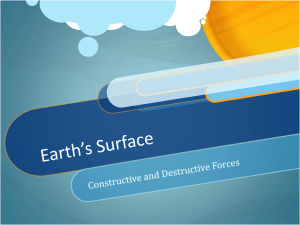
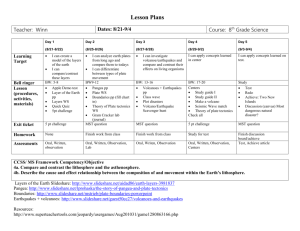
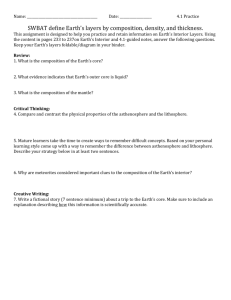

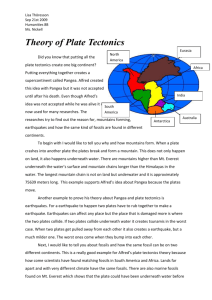

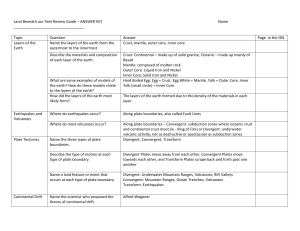
![Pangea will happen again in the future digital essay[1].](http://s2.studylib.net/store/data/005276212_1-2740c3f7ca47aee10356b44542740905-300x300.png)
